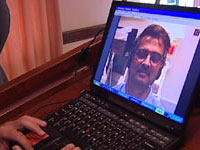Project: StrokeDoc Multimedia Telemedical Diagnostic
System
PI: Ramesh Rao, Prof, Jacobs School of Engineering;
UCSD Division Director, Calit2
Funding: Nat'l Institute of Neurological Diseases
and Stroke, NIH
Division: UCSD
Corporate Partners: QUALCOMM Inc., Path 1 Network
Technologies, Inc.
Start Date: June 2003
PDF: PDF
DOC: DOC
|
 |
|
Time is critical in stroke treatment. Every 53 seconds in America,
someone has a stroke, interrupting blood flow to the brain. Chances
of recovery are significantly improved if treatment begins within
three hours of stroke onset, but too many strokes result in death
or severe disability due to delays in diagnosis and treatment. Only
30% of stroke victims arrive at the hospital in time to be considered
candidates for an effective type of clot-busting therapy called
thrombrolysis. Of these patients, only about 20% receive the therapy,
often because physicians are unsure if the patient is an appropriate
candidate for the treatment. To improve those statistics, Calit2
scientists are tailoring new broadband, wireless video technologies
to make it possible for a specialist to participate in emergency
long-distance consultations with patients soon after the onset of
symptoms.
"We are delighted that this project provided an opportunity
to not only piece together state-of-the-art technologies from
Calit2 industrial partners, but also enhance them in a unique
way to provide a solution that satisfied the needs of this project.
We are convinced that what we have learned from this experience
is more broadly applicable."
- Ramesh Rao, UCSD Division Director,
Calit2 |
This StrokeDoc
telemedical system is part of a wider 5-year, $5-million project
led by UCSD School of Medicine professor Patrick Lyden, M.D., and
integrates expertise and advanced technologies in three areas -
video processing, real-time cellular packet-data transport, and
medicine. The prototype system provides an emergency room or clinic
with access to medical specialists in other locations by means of
a common-place personal laptop computer connected to the Internet
via conditioned last-mile access loops and next-generation cellular
data transport technologies. The system combines advanced video
compression and synchronization technologies, new technologies to
guarantee the quality of service (QoS) for real-time video and medical
telemetry over IP networks, and new mobile wireless data communications
technologies. The innovations necessary to adapt the technologies
to the project include improvement of the wireless QoS mechanisms
to help ensure the quality of the video feed to the physician so
as to enable correct diagnosis.
Several community hospitals are participating in the UCSD clinical
trial. When a suspected stroke patient arrives in the emergency
room, the local physician sends live video of the patient to a wireless
laptop computer operated by the on-call member of the UCSD Stroke
Center team. The specialist participates in the physical exam as
it takes place, consults with the community physician, and advises
in administration of appropriate drugs.
Contact: Ramesh Rao, (858) 822-4572, rrao@ucsd.edu
|

